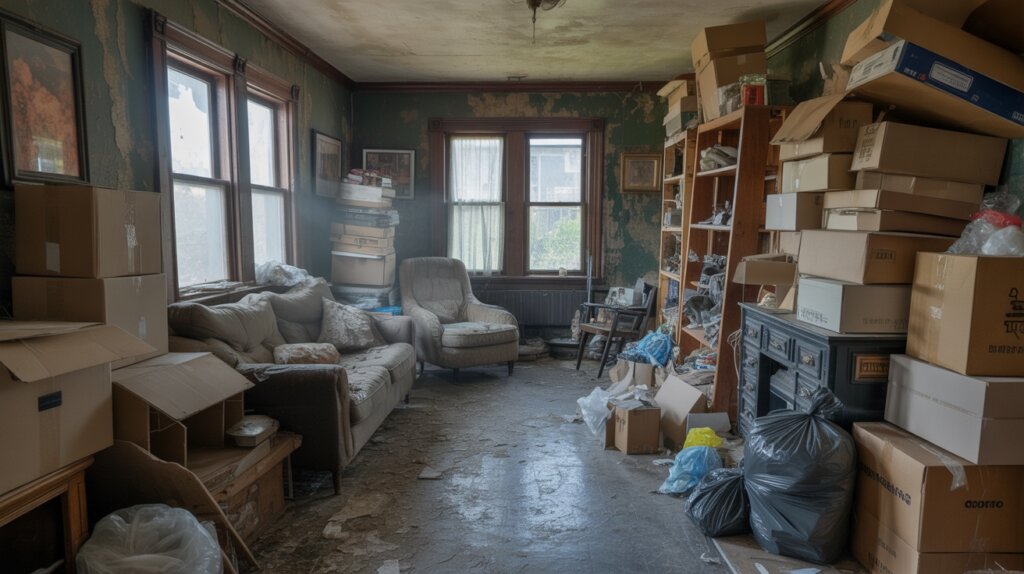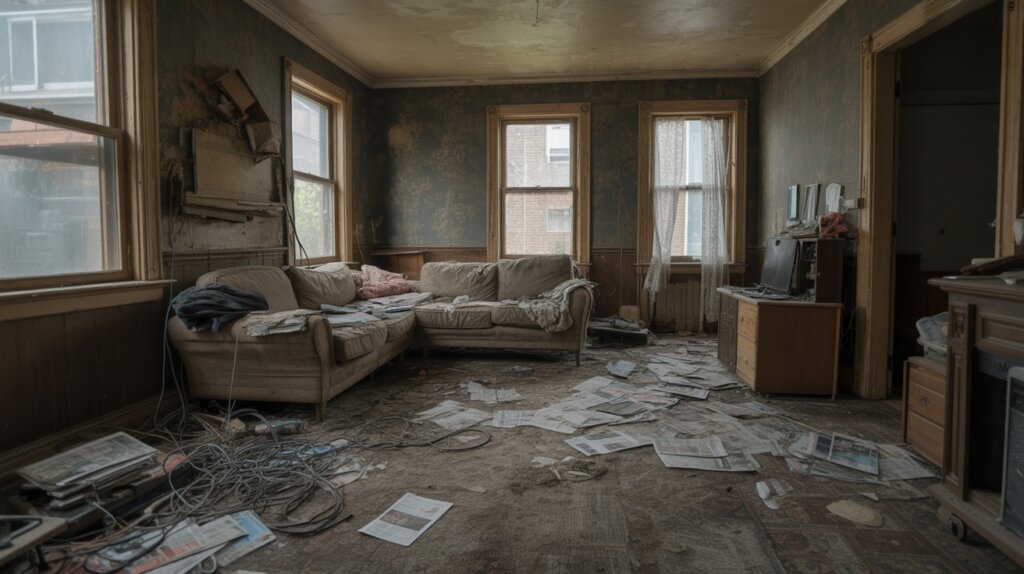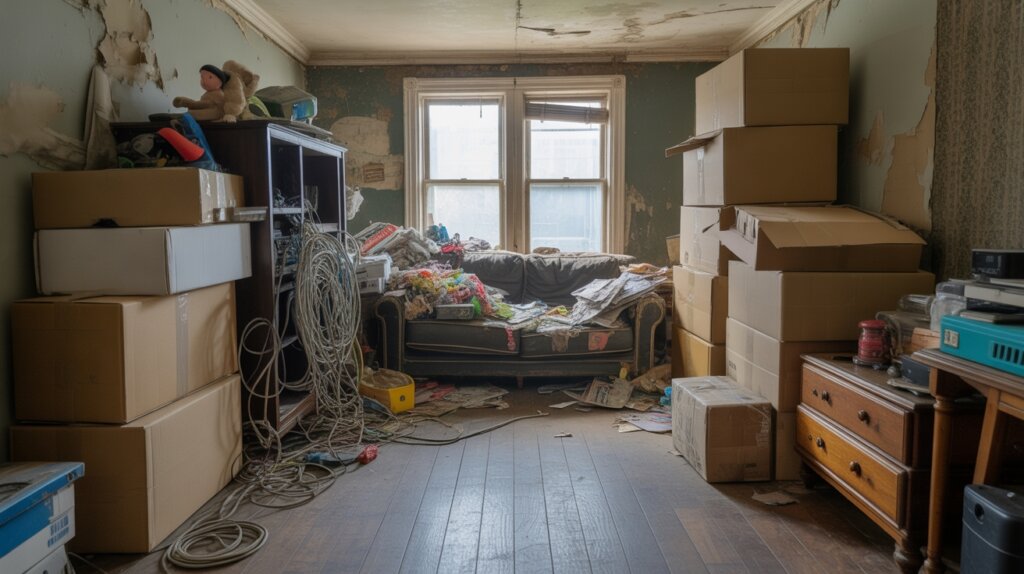Hoarding is more than just clutter; it can seriously affect the value of a property. When excessive belongings take over a home, they create safety risks and hidden issues. These problems make selling or buying a home much harder.
As things pile up, buyers hesitate to invest, and appraisers lower their estimates. The home can feel unsafe and difficult to navigate. Repairs often go unnoticed, leading to further drops in value. Hoarding can reduce property value by up to 10–15%.
The good news is there are practical ways to address and fix these problems. By understanding the impact and taking steps to clear and repair, you can protect your investment. This blog will guide you through simple solutions to help restore a hoarded home’s value.
Key Takeaways
- Hoarding significantly reduces property value by 5–15% due to clutter, structural damage, and safety hazards.
- Excessive clutter hides maintenance issues, leading to costly repairs and deterring potential buyers.
- Hoarding blocks access for inspections, lowering appraised values and complicating financing or insurance.
- Homes with hoarding problems spend 25–50% longer on the market and receive lower offers.
- Neighborhood property values may decline as hoarded homes diminish curb appeal and market competitiveness.
Understanding Hoarding and Its Severity

Hoarding is not just clutter; it is a serious mental health disorder. This condition can damage property and lower its market value. If you work in real estate, you should understand how serious hoarding can be. The International OCD Foundation says hoarding affects 2-6% of people. People with this disorder hold onto items because of strong emotional ties. If they cannot throw things away, their homes fill up over time.
Property investors should see hoarding as more than a messy space. It can mean expensive repairs and cleaning are needed. If you are evaluating a property, you must consider hoarding when judging its value and risks. Recognizing the severity of hoarding is crucial for assessing potential costs and challenges associated with such properties.
Structural Damage Caused by Excessive Clutter
You’ll face significant property risks when excessive clutter leads to higher pest infestations, hidden moisture, and mold growth. Data shows that overloaded floors and walls can suffer structural stress, accelerating depreciation and repair costs. These factors directly impact a home’s market value and buyer appeal.
Additionally, disclosing all known issues about the property’s condition can help mitigate legal complications and build trust with potential buyers. Implementing thorough disclosures can also prevent future disputes related to undisclosed defects, which could otherwise lead to costly legal battles or claims against the property.
Increased Pest Infestations Risk
Excessive clutter increases the risk of pest infestations in a property. Clutter gives pests like rodents, cockroaches, and termites more places to hide. If clutter is not managed, pest problems can get worse and harder to control.
Pests find food and shelter in messy areas, making control more expensive. The National Pest Management Association says infestations can lower property value by up to 20%. Health risks also rise, as pests carry diseases and allergens.
Buyers may see homes with pest issues as risky investments. If a property has a history of infestation, it may get lower offers. To protect property value, owners should reduce clutter and use good pest control methods.
Hidden Moisture and Mold
Excess clutter blocks airflow and traps moisture, which can cause hidden mold to grow. Mold often develops in places you cannot see or easily reach. If ignored, this problem can quickly get worse.
Homes with mold often lose value, sometimes up to 30%. Buyers notice mold and expect expensive repairs. Inspectors usually flag mold issues, making it harder to sell your home.
Clutter can also hide leaks or condensation, making moisture control difficult. If insulation problems exist, these can make mold grow faster. Over time, hidden mold damages the structure and increases repair costs.
Floor and Wall Stress
Excess clutter puts too much weight on floors and walls. This extra weight can cause floors to sag or even break. Walls may crack or buckle if items are stacked against them.
If belongings keep piling up, the damage gets worse. Floors may need expensive repairs, like joist reinforcement. Walls may require full reconstruction to fix the damage.
Repair costs for these problems can be more than $8,000 per room. Buyers and appraisers notice these issues right away. If you ignore the risks, your home’s value will likely drop and repairs will be costly.
Hidden Maintenance Issues
You’ll find that hoarding often blocks access to key utilities, making regular inspections and repairs nearly impossible. This neglect accelerates structural deterioration, which data shows can lower property values by up to 15%. In competitive markets, buyers factor these hidden risks into their offers, reducing your potential return.
Additionally, legal and compliance issues, such as liens or code violations, may arise due to neglect, further decreasing property appeal. Proper maintenance and clearing pathways can significantly protect property value and prevent these issues from escalating.
Blocked Access to Utilities
Buyers often ignore blocked access to utilities when checking a property’s value. This mistake can lower a home’s price and appeal. If utilities are blocked, the property becomes harder to sell.
Blocked access to plumbing, electrical panels, or HVAC systems stops inspections and repairs. Hidden issues, like covered breaker boxes, worry appraisers and inspectors. If buyers see these problems, they may not make an offer.
Industry data shows homes with utility access issues can sell for 15% less. Fewer buyers are willing to take these risks. In today’s market, clear access to utilities is essential for a sale.
Accelerated Structural Deterioration
Hoarding can cause a home to wear out faster. Clutter blocks walls and floors, hiding problems like mold or leaks. If maintenance is missed, the house can lose value quickly.
Homes with hidden damage often sell for 5-10% less. Buyers may lower their offers or walk away if repairs are needed. Major systems are hard to reach, making small issues worse over time.
If you use good storage and declutter regularly, you can spot problems early. These steps make cleaning and repairs easier. They also help keep your home strong and valuable.
Increased Health and Safety Risks

Hoarding increases health and safety risks in a property. Clutter blocks exits, makes fires spread faster, and slows emergency response. If you own or invest in property, you should know these dangers can harm people and property. Heightened safety concerns are especially relevant when considering the potential impact on property value and the urgency of repairs or cleanouts. Fire dangers are higher in homes with hoarding.
The National Fire Protection Association says injuries and deaths are more common in these fires. Insurance companies may refuse coverage if they find severe hoarding. Improper storage of cleaners, chemicals, or flammable liquids can cause leaks or dangerous reactions. These chemical risks can lead to more accidents. Property condition and the presence of hazards can significantly decrease property value and deter potential buyers. If buyers see these hazards, they may avoid your property and lower its value.
Impact on Home Appraisals
When you’re preparing for a home appraisal, hoarding can significantly reduce the perceived usable living space and highlight major safety hazards. Appraisers often record lower values when clutter obstructs thorough inspections or raises concerns about structural access and code compliance.
Data shows that homes with these issues see diminished market competitiveness and increased risk of appraisal gaps. Additionally, proper disclosure of property issues, including hoarding, is essential to ensure legal compliance and avoid future disputes.
Reduced Usable Living Space
Hoarding reduces the amount of living space in a home. Appraisers count only livable areas when deciding property value. If rooms are blocked or crowded, the home seems smaller and less useful.
Buyers want open and usable rooms. Clutter makes spaces look cramped and lowers buyer interest. Some reports show homes with hoarding can be worth 5–10% less than similar houses.
If you remove clutter and use storage, you can restore space and attract more buyers. Clean and open homes usually sell faster and for better prices. If you do not address hoarding, your home may stay on the market longer and get lower offers.
Increased Safety Hazards
Hoarding creates serious safety hazards in a home. These dangers can lower the home’s appraised value right away. If there is too much clutter, it increases the chance of fire and blocks exits.
Firefighters may not be able to get inside quickly during emergencies. The National Fire Protection Association says cluttered homes have a higher risk of severe fire damage. Appraisers notice these risks and may lower the home’s value.
Heavy piles of items can also hurt the home’s structure. Storing heavy things on upper floors or weak walls could cause damage. If buyers or lenders see these hazards, they may offer less money or ask for repairs.
Obstructed Home Inspections
Cluttered interiors can lower a home’s appraisal. Appraisers need to see all areas to judge the home’s value. If they cannot access certain spaces, they may give a lower appraisal.
Blocked views can hide damage like leaks or bad wiring. Appraisers may lower the value if they suspect hidden problems. Any area that cannot be inspected may reduce the home’s overall worth.
If you use better storage and decluttering methods, you can help appraisers see every room. Clean, open spaces make inspections easier and faster. Homes that are easy to inspect usually get higher appraisals in the market.
Difficulty in Staging and Showing the Property
Hoarding makes it hard to stage and show a property. Clutter blocks key features and lowers the home’s appeal. Buyers may lose interest quickly if they see too much stuff.
If rooms are full, buyers cannot imagine their own furniture fitting in the space. Professional stagers also struggle to arrange furniture well. This can make the home seem smaller than it is. Additionally, overpricing can further hinder the sale, as the market tends to respond better to correctly priced homes.
Photos for online listings will look crowded if clutter remains. Less inviting photos may reduce the number of showings. If clutter is not cleared, the home might take longer to sell and bring a lower price. Proper home preparation can help mitigate these issues and attract more potential buyers.
Negative First Impressions for Potential Buyers

When buyers walk into a home overwhelmed by visual clutter, 80% report an immediate negative reaction, according to real estate surveys. You risk them perceiving the property as neglected and in need of substantial maintenance. This perception can reduce buyer interest and lead to lower offers, directly impacting your property’s market value.
Additionally, visual clutter can obscure the home’s best features, making it harder for buyers to envision themselves living there. Recognizing the importance of market value assessment can help sellers understand how first impressions influence pricing and offers.
Overwhelming Visual Clutter
Overwhelming visual clutter can make buyers lose interest in a property. Clutter hides a home’s best features and makes spaces look smaller. If buyers see too much mess, they may offer less money.
Market studies show that first impressions matter. Clutter can lower a home’s value by up to 10%. Buyers might ignore any improvements if rooms look crowded.
If entryways are blocked or windows covered, buyers may feel the home is not well cared for. Hidden floors and walls suggest there is not enough space. Overfilled closets also make storage look limited.
Perceived Maintenance Neglect
Hoarding makes buyers worry about poor maintenance. If a home looks cluttered, buyers think repairs may be neglected. This can lead to lower offers.
Studies show neglected homes sell for up to 15% less than well-kept ones. Buyers may believe if clutter is ignored, bigger issues like plumbing or wiring are too. This fear reduces your property’s value and interest from buyers.
If you want to protect your investment, keep your home tidy and well-maintained. Simple storage solutions help make a good first impression. Regular decluttering can assure buyers the home is cared for.
Legal and Insurance Complications
Even small hoarding problems can cause legal and insurance issues for your property. These issues can lower your property’s value. Property owners may face more checks from insurance companies and city officials.
Insurance claims for damage may be denied if hoarding is a cause. Some insurance companies may cancel or refuse coverage after they see too much clutter. Mortgage lenders could also refuse loans if they think the property is too risky.
If local rules are broken, the city can fine you or force you to clean up. Buyers may avoid your property if they worry about future problems. Ignoring these risks can make your property harder to sell.
Higher Cleaning and Restoration Costs

Hoarding leads to much higher cleaning and restoration costs than normal cleaning. Professional cleanup for hoarded homes can cost $3,000 to $15,000. The price depends on how severe the hoarding is.
If there are strong emotional ties to items, simple cleaning will not be enough. Special crews may need to deal with biohazards and repair damage. Deep cleaning and repairs add to the final bill.
Delaying cleanup usually makes the problem worse. More damage means higher costs later on. Property managers and investors should always include these costs in their planning.
In addition, local expertise can be invaluable in assessing the scope of cleanup and restoration needed. If you ignore the true costs, you could underestimate your expenses. This can lead to financial losses or incorrect property values. Hoarding-related damages can significantly decrease property worth if not addressed promptly. Careful budgeting is key when dealing with hoarded properties.
Decreased Marketability
Hoarding can make a property much harder to sell. Buyers often avoid homes that look cluttered or poorly maintained. These homes usually attract less interest and lower offers. Cluttered or poorly maintained homes deter buyers and lead to less interest, making properties much harder to sell.
Cluttered spaces hide the true size and function of rooms. Buyers might think there are hidden repairs or problems. Poor organization can also make storage look inadequate.
If you want better marketability, you must clear out clutter and clean thoroughly. Professional staging works best in tidy spaces. Effective decluttering can help restore buyer confidence in your property. Additionally, a home’s value depends on what someone is willing to pay, so improving presentation can positively influence perceived worth.
Lower Offers and Extended Time on Market
Hoarded properties usually get lower offers and stay longer on the market. Buyers see clutter and expect extra work and costs. These homes often sell for less money than similar clean homes.
If a home looks messy, buyers worry about repairs and health risks. Such homes spend 25% to 50% more time waiting for buyers. Delays can increase your expenses and cause you to miss better deals.
Homes with good storage and tidy spaces sell faster and closer to the asking price. Data shows that organizing a home gives better returns and shortens selling time. If you invest in decluttering, you are more likely to attract buyers.
Neighbourhood Perception and Property Values
A hoarded property can lower how people see the whole neighborhood. Property values often drop if even one home looks neglected. Buyers and appraisers notice these problems right away.
Appraisers may give lower values to homes near a hoarded property. Real estate agents say home prices can fall by 5-10% in these cases. Prospective buyers might skip homes in such areas.
Negative talk about the neighborhood can scare off future buyers. If this happens, trust in the area drops. Everyone’s property value may suffer as a result.
Challenges in Securing Financing
Lenders often hesitate to approve mortgages for homes near hoarded properties. A nearby hoarded house can lower your home’s value by 5–10%. This makes getting a loan harder, even if your own property is well-kept.
Mortgage underwriters look at neighborhood conditions and property values. If they see clutter or neglect next door, they may offer lower loan amounts or raise interest rates. Safety issues or pest problems can also make financing more difficult.
Appraisers may mention these risks in their reports. Buyers might then face stricter loan terms or even loan denial. These challenges can affect both buying and future resale options.
Steps to Restore Value After Hoarding
Restoring your home’s value after hoarding starts with careful cleanup. If you follow these steps, your property can gain back 10-25% in value. Homes that are clean and orderly attract more buyers.
Begin by sorting all items in the home. Decide what to keep, donate, or throw away. Focus on removing clutter to create open spaces.
If you invest in custom storage, your home will look organized and modern. Modern storage solutions help rooms feel spacious. Organized homes appear more valuable to buyers.
Deep cleaning is important to remove odors and stains. You should hire professionals if there are stubborn smells or damage. Clean homes make a better impression.
Complete any repairs on walls, floors, and fixtures. Fixing damage restores the home’s structure and appeal. Buyers are more likely to pay full price for well-maintained homes.
If you take these steps, you will likely regain buyer interest. Property value can recover quickly with the right approach. Each step brings you closer to a market-ready home.
Conclusion
If you want to maintain your property’s value, it is important to address hoarding issues early. Hoarding can cause lower appraisals, higher repair costs, and fewer buyers. If sellers do not tackle clutter, they may lose up to 15% of their home’s value.
If homeowners decide to sell, hoarding can make the process longer and more stressful. Buyers may hesitate due to the extra work and repairs involved. If you want a faster, easier sale, removing clutter is essential.
If you need to sell quickly, we buy houses for cash in any condition. We at Greg Buys Houses can help you move forward without costly repairs or delays. Contact us today to see how we can help you sell your home with less hassle.

